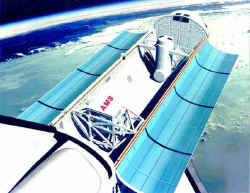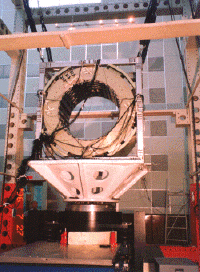对宇宙间最高能粒子进行探测是一项技术挑战。把仪器设备安置在高空气球和卫星上带上天空进行的天体物理观测实验更加困难。如果是为了探测来自恒星和星系的X射线或γ射线辐射,这项技术就有很大的意义。地球大气是这些种辐射的强吸收物,气球或卫星能使观测在大气以上进行。另一方面,如果打算用这种办法捕捉超高能宇宙射线,就必须有极大的耐心。能量高于1019eV的宇宙射线粒子,平均每年在1平方公里的面积上只落下一颗。换成空间观测,利用面积为1平方米的典型卫星探测器拦截的话,等待100万年才有可能探测到1颗这类宇宙射线的粒子!
-
ACE [Advanced Composition Explorer] Mission mainly for solar particles; launched in August 1997.
-
AGILE [Astro-rivelatore Gamma a Immagini LEggero] X-ray/gamma ray mission to be launched in October 2006.
-
AMS [Alpha Magnetic Spectrometer] Detector to be flown on the International Space Station
利用强磁场和精密探测器来探测宇宙空间的反物质和暗物质,探索和研究宇宙物理学、基本粒子物理学和宇宙演化学的一些重大和疑难问题的阿尔法(α)磁谱仪(Alpha Magneitic Spectrom-eter,简称AMS)的研制工作正在进行。AMS是人类送入宇宙空间的第一个大型磁谱仪,这是美籍华裔物理学家丁肇中教授提出并领导的大型国际合作科学研究项目,由美国和中国等10多个国家和地区的37个科研机构参加科研工作。
AMS由一个直径约1.2米、高0.8米、重量约为1.85吨的圆环形永磁体产生均匀的平行磁场,磁束密度约为0.15特斯拉。圆环内安装6层硅微调探测器,用来记录带电宇宙射线粒子的运动轨迹。一个带正电荷的粒子在穿过磁场时,其运动方向将与带负电的相反。 根据每层记录下来的带电粒子穿过的轨迹,可以推算出粒子的偏转方向及带电荷的大小。带电荷量愈大,在穿过每层硅微调探测器时能量损失愈快。具有较大动量的粒子在穿过探测器时偏转的角度较小,从而可以估计出粒子的质量。磁谱仪的上、下两层还装有闪烁体,当粒子穿过时会发出亮点,其亮度与粒子穿过时的能量成正比。通过上、下两层光点亮度及穿过瞬间的比较,可以得出粒子能量的损失大小以及粒子穿过所需的时间。反物质、暗物质在磁场中运动时会表现出不同的特点,因而可以探测出来。1998年6月AMS搭载美国"发现号"航天飞机成功地进行了首次飞行,进行了约10天的试验性探测,取得了许多重大物理成果。计划于2008年升空进入由美、
根据每层记录下来的带电粒子穿过的轨迹,可以推算出粒子的偏转方向及带电荷的大小。带电荷量愈大,在穿过每层硅微调探测器时能量损失愈快。具有较大动量的粒子在穿过探测器时偏转的角度较小,从而可以估计出粒子的质量。磁谱仪的上、下两层还装有闪烁体,当粒子穿过时会发出亮点,其亮度与粒子穿过时的能量成正比。通过上、下两层光点亮度及穿过瞬间的比较,可以得出粒子能量的损失大小以及粒子穿过所需的时间。反物质、暗物质在磁场中运动时会表现出不同的特点,因而可以探测出来。1998年6月AMS搭载美国"发现号"航天飞机成功地进行了首次飞行,进行了约10天的试验性探测,取得了许多重大物理成果。计划于2008年升空进入由美、 俄、西欧、日本和加拿大等国联合研究的“国际空间站”进行长达3―5年的数据采集工作。(左图为“发现号”航天飞机上的AMS)
俄、西欧、日本和加拿大等国联合研究的“国际空间站”进行长达3―5年的数据采集工作。(左图为“发现号”航天飞机上的AMS)
中国在这项重要的研究和应用中也作出了重要的贡献。高能所等单位承担大型永磁体系统的设计、研制、测试和空间环境模拟实验。(右图为AMS01永磁体系统在北京进行震动实验)
AMS二期工程中高能所参加了最重的子探测器--电磁量能器AMS-02的研制。AMS-02设计载荷要求最高、最苛刻,高能所研制的初样成功通过了空间环境模拟试验,达到了美国NASA的技术要求,并依据所建立的有限元模型对AMS-02作了减重,对飞行件设计方案作了相应的修正。AMS-02飞行件主体总装和空间环境模拟试验于2004年完成,通过了NASA专家的严格审查。中国在研制过程中掌握了数项国内以往没有成熟经验的先进试验技术及模拟计算修正技术,获得了很高的国际显示度。
-
ASCA [Advanced Satellite for Cosmology and Astrophysics] (X-ray mission but with some cosmic-ray relevant results, see also here). Observations ended July 14, 2000.
-
BeppoSAX [Satellite per Astronomia X] (operational May 1996 - April 2002)
-
Chandra X-ray satellite
-
CGRO [Compton Gamma Ray Observatory] (mission terminated) with the four experiments:
-
BATSE [Burst And Transient Source Experiment]
-
OSSE [Oriented Scintillation Spectrometer Experiment]
-
Comptel [imaging Compton telescope] (also here)
-
EGRET [Energetic Gamma Ray Experiment Telescope]
-
Geotail (measures the Earth's magnetotail)
-
GLAST [Gamma ray Large Area Space Telescope] (to be launched in Oct. 2007, see also NASA page)
-
GRANAT gamma-ray satellite with several experiments (SIGMA, WATCH and others) was turned off November 27, 1998
-
HETE [High-Energy Transient Experiment] (launch failed on 4 Nov. 1996) has a follow-up:
HETE-2 (launched October 9, 2000).
-
IMP-8 (Interplanetary Monitoring Platform)
-
INTEGRAL [INTErnational Gamma-Ray Astrophysics Laboratory] (launched October 17, 2002)
-
NINA [New Instrument for Nuclear Analysis], a mission for low energy cosmic rays.
-
PAMELA (magnet spectrometer, launched June 15, 2006). See also here.
-
Polar (examines the Earth's magnetosphere and ionosphere)
-
Rosat X-ray satellite (ended February 12, 1999)
-
RXTE [Rossi X-ray Timing Explorer]
-
SAMPEX [Solar Anomalous Magnetospheric Particle Explorer]
-
Spectrum-X-Gamma satellite is a future mission (see also here and here)
-
Suzaku X-ray satellite (Astro-E2 mission, see also this NASA page)
-
SWIFT (gamma ray burst mission, launched November 20, 2004)
-
Ulysses (explores interplanetary space at high solar latitudes)
-
Voyager (two spacecrafts heading towards interstellar space)
-
WIND (explores solar wind and plasma processes near the earth as well as gamma-ray bursts)
-
XMM-Newton [X-ray Multi-mirror Mission] (see also pages at GSFC)
Some missions/experiments proposed or under development:
-
ACCESS [Advanced Cosmic ray Composition Experiment for the Space Station] (see also pages at U. of Maryland)
-
AGILE [Astro-rivelatore Gamma a Immagini LEggero] (a light-weight gamma-ray imager, see also here)
-
Andromeda (a coded-aperture gamma-ray telescope)
-
BLAST [Burst Locations with an Arc Second Telescope]
-
EUSO [Extreme Universe Space Observatory ] (see also under fluorescence experiments)
-
MEGA [Medium Energy Gamma-ray Astronomy]
-
OWL [Orbiting Wide-angle Light-collectors] (see also under fluorescence experiments)
For a comprehensive list of high-energy astrophysics missions see here. For a list of gamma-ray missions see also this page.



